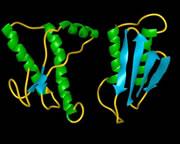 It is still unclear how long the protein that causes vCJD can lie dormant in the brain.© AP Photo/Professors Stanley Prusiner/Fred Cohen
It is still unclear how long the protein that causes vCJD can lie dormant in the brain.© AP Photo/Professors Stanley Prusiner/Fred CohenPeople in Papua New Guinea who once feasted on their own relatives succumbed to prion disease as much as half a century later, say scientists who have laboriously tracked down the last sufferers in remote villages.
The discovery renews concerns that another prion disease, variant Creutzfeldt-Jakob disease (vCJD), might also be incubating silently and will only rear its head decades from now.
Neurologists have long been fascinated by kuru, which caused an unprecedented epidemic in the Fore people of Papua New Guinea that peaked in the 1950s and early 1960s. Families steamed and ate the entire bodies of their relatives in a death ritual, unwittingly ingesting the infectious prion proteins that cause the debilitating neurological disease. But the practice stopped when it was prohibited by Australian authorities in the mid-1950s.
Scientists' interest in kuru renewed with the realization that vCJD, transmitted from cows infected with bovine spongiform encephalopathy (BSE), might also cause an epidemic amongst those who ate infected beef in the 1980s and 1990s.
So far, 156 vCJD deaths have been reported in Britain, the worst-affected country, and the number of new cases peaked in 2000, suggesting that the disease takes around 10 years to incubate. But there is still debate about the eventual size of the epidemic; no one knows whether many more are actually infected or for how many years they might incubate the disease before they show symptoms.
Bush mission
“It's sobering that half a century on, this disease has not disappeared.”
John Collinge
University College London
John Collinge at University College London, UK, and his colleagues went to Papua New Guinea to find out. Most people who had kuru have already died, but the team ramped up existing disease monitoring in an attempt to find the last vestiges of the epidemic: those people who harboured the infectious prions for many years and are only just developing the disease.
Working with local communities, they scoured isolated villages, which are typically located at mountainous altitudes above 2,000 metres, lost in dense, wet rainforest and often connected only by tracks. "It's arduous trekking," Collinge says.
From 1996 until mid-2004, the team found what they believe to be the final 11 remaining cases of kuru, which often manifests itself as problems with balance and coordination. The researchers also collected people's life histories to piece together when they were likely to have been infected.
Because the cannibalistic ritual had stopped by 1960, the team calculated the incubation time as the time between 1960 and the year that a patient first exhibited kuru symptoms. This suggested an incubation lasting between 34 and 41 years, although the researchers did not know exactly when, before 1960, a person was infected.
New numbers
They then sought to obtain a more accurate estimate, based on the knowledge that boys stopped taking part in the cannibalistic ritual at around the age of seven. For their male patients, they therefore subtracted seven years from the age that they first showed symptoms.
This gave a longest incubation time of 56 years, and perhaps up to seven years longer, although the average incubation time is thought to be 12 years they report in The Lancet1. "For the first time we can see the extraordinary incubation period in human prion disease," Collinge says. "It's sobering that half a century on, this disease has not disappeared."
ADVERTISEMENT
Collinge says that vCJD could well have an average incubation time of 30 years or longer (more than the average for kuru) because the prions are passing from cows to humans rather than from human to human. This species barrier is known to extend incubation times in animal tests. The people who have already succumbed to vCJD could have been those with the shortest incubation period, perhaps because they were particularly genetically susceptible, as other evidence has suggested.
Mathematical models used to predict the size of the likely vCJD epidemic could now take these findings into account. "Most people seem to be thinking that we're over the worst of it," Collinge says. "We have to be cautious about assuming this disease is going away."
Visit our diseasecan_incubat.html">newsblog to read and post comments about this story.
University College London
